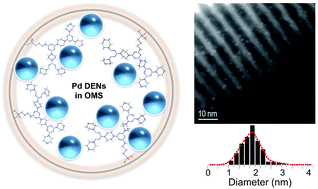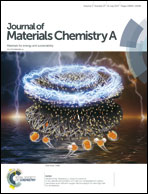Palladium dendron encapsulated nanoparticles grown from MCM-41 and SBA-15†
Abstract
The synthesis and characterization of palladium nanoparticles templated in melamine-based dendrons grown from ordered mesoporous silica (OMS) are reported. The metal complexation and reduction are monitored by UV-vis spectroscopy which shows that the palladium loading can be varied from 1 wt% to 3 wt%. The STEM images show the formation of uniformly sized palladium particles approximately 2 nanometers in size within the OMS pores. In contrast to prior work with dendrimers in solution where G4 or higher generation moieties were needed here it is shown that highly uniform nanoparticles can be formed in small dendron fragments, i.e. G2. The accessibility of both the metal sites and dendron ligand sites was demonstrated by catalytic probe reactions and CO2 uptake experiments. The TOF values for the Heck reaction vary from 160 to 239 mmol iodobenzene consumed per mmol Pd demonstrating that the encapsulated palladium particles are catalytically active. The initial rate for the nitroaldol (Henry) reaction decreases from 14.9 to 7.3 mmol aldehyde consumed per g catalyst per h but nonetheless shows that the amine sites are catalytically active in the palladium-containing samples. Carbon dioxide uptake measurements showed minimal perturbations to the CO2 uptake after palladium particle formation. These hybrid materials have potential uses in reactions where both the organic and metal center can be used sequentially such as cascade reactions.



 Please wait while we load your content...
Please wait while we load your content...